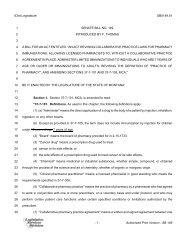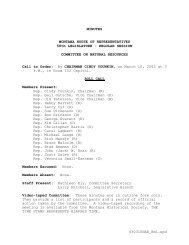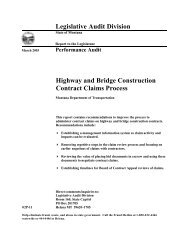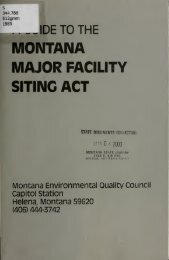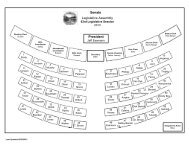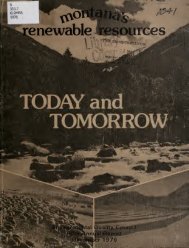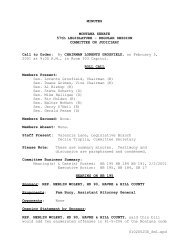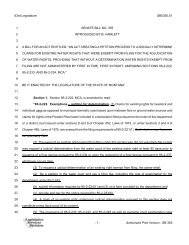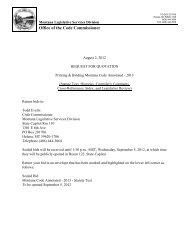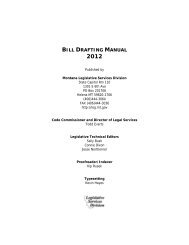Public Comment. Volume III - Montana Legislature
Public Comment. Volume III - Montana Legislature
Public Comment. Volume III - Montana Legislature
Create successful ePaper yourself
Turn your PDF publications into a flip-book with our unique Google optimized e-Paper software.
Other exemptions, waivers, or reductions in<br />
the application andlor rental fees may apply and<br />
can be explained by BLM officials during the<br />
preapplication meeting.<br />
Remember to Plan Ahead<br />
You should arrange for your preapplication<br />
meeting well in advance of when you would like to<br />
start work on the project. Processing time for an<br />
average grant is 60 to 90 days. However, grants<br />
for complex projects can take much longer. Try to<br />
contact the BLM as soon as possible. The Area<br />
Manager and staff are ready to provide information,<br />
advice, and assistance to help you prepare an<br />
application.<br />
Processing a<br />
Right-of-way Application<br />
Once you have filed an application, the BLM<br />
reviews it to make sure all needed information<br />
has been included. The application is then evaluated<br />
to determine the probable impact of the<br />
activity on the social, economic, and physical<br />
environments. It is also compared with existing<br />
land use plans and any existing rights or previous<br />
right-of-way grants.<br />
A right-of-way application may be<br />
denied for any one of the following reasons:<br />
- The proposal is inconsistent with the purpose<br />
for which the public lands are managed.<br />
- The proposal would not be in the public<br />
interest.<br />
- The applicant is not qualified.<br />
- The proposal is inconsistent with Federal,<br />
State, or local laws.<br />
- The applicant is not technically or financially<br />
capable of accomplishing the project.<br />
- Serious environmental consequences<br />
that cannot be mitigated would result.<br />
A preapplication meeting will reduce the<br />
possibility of the application being denied.<br />
Appeal Rights<br />
If the application is denied, the official written<br />
notice will give the reasons for the denial and<br />
information on how to file an appeal, should you<br />
so desire.<br />
Liability<br />
The holder of a right-of-way grant is responsible<br />
for damage or injuries to the United States<br />
Government in connection with the holder's use<br />
of the right-of-way.<br />
The holder indemnifies or insures the United<br />
States Government harmless for third party<br />
liability, damages, or claims arising from the<br />
holder's use and occupancy of the right-of-way.<br />
Your Right-of-way Responsibiiities<br />
Once you have a right-of-way grant, you can<br />
proceed with your plans. However, there are a<br />
number of responsibilities you should keep in<br />
mind. The following questions and answers help<br />
explain these responsibilities.<br />
Q. How do I handle removal of resources<br />
like timber?<br />
A. If there are any marketable products<br />
(such as timber) that have to be<br />
removed before construction can begin,<br />
you may be required to purchase them<br />
under a separate contract.<br />
Q. If I want to substantially change,<br />
improve, or add to my project once I have<br />
a right-of-way grant, do I have to get<br />
BLM's approval?<br />
A. Yes. You must file an application to<br />
amend your right-of-way grant and<br />
receive prior written approval from the<br />
BLM for any substantial change in<br />
location or authorized use during<br />
-1 66- <strong>Volume</strong> Ill: <strong>Public</strong> <strong>Comment</strong>



